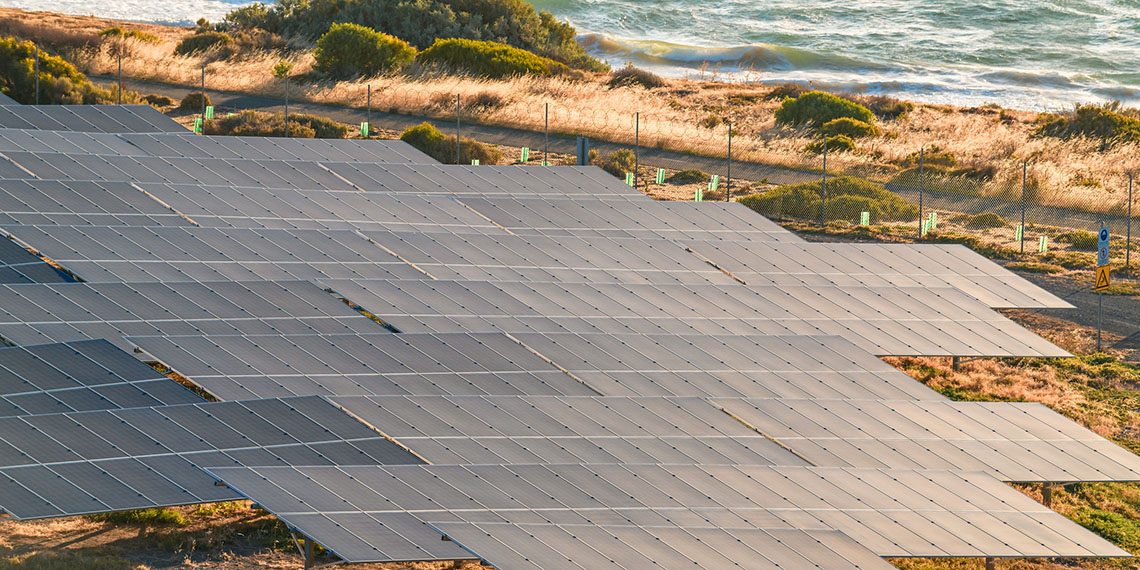Lighting it up: how SA Water became a solar powerhouse

Just four years ago, SA Water embarked on a mission to significantly reduce its reliance on grid electricity. Now, the utility boasts a whopping 360,000 solar panels embedded at tanks, pipelines and pump stations across the state.
SA Water Zero Cost Energy Future Senior Manager Nicola Murphy said the utility’s solar plans were part of a larger goal to neutralise operating costs for the benefit of customers and deliver sustainable environmental outcomes.
“We’re one of South Australia’s single largest electricity users, with our energy-intensive drinking water and wastewater pumping and treatment operations across the state costing approximately $86 million in 2020-21,” she said.
Stellar focus
Murphy said the Zero Cost Energy Future program, which endeavors to offset the cost of electricity into the future, is an ambitious plan that will be delivered by an exponential increase in renewable energy generation and storage capacity, particularly via solar.
“In the same way that many Australians have harnessed the benefits of solar panels at home, we’re making some of our physical assets work harder for us, taking advantage of our large buildings, roof spaces and land holdings to generate a sustainable source of energy,” she said.
“154 megawatts of solar photovoltaics are harnessing the power of the sun across existing footprints, including our Bolivar Wastewater Treatment Plant, Happy Valley Water Treatment Plant, and pump stations along the Morgan to Whyalla Pipeline.”
Once progressively energised and connected to the national grid, these sites will generate 242 gigawatt hours of clean, green solar energy per annum, combined with 34 megawatt hours of battery storage, Murphy said.
“Combined, these solar arrays will have the capacity to generate around 70% of our annual electricity needs in an average weather and water consumption year,” she said.
“There will still be times when we draw electricity from the grid, but we’ll offset those costs by storing and selling energy we produce at other times, to bring our net external electricity expenses down.”
Reducing emissions
Further to offsetting operation costs, Murphy said the utility’s solar focus is also about reducing its carbon footprint, as it works alongside the national water community towards net zero emissions targets.
“The most significant challenge facing our industry right now is climate change and its impact on water supply, therefore, it’s vitally important that water and wastewater utilities explore opportunities to reduce their carbon footprint,” she said.
“We’re significantly reducing carbon emissions through our $300 million solar investment, with the estimated 89,000-tonne reduction equivalent to planting more than 7,000,000 trees or removing 32,000 cars from the road per year, every year of operation.”
Murphy said investing in solar was the clear option for SA Water, as it enabled the utility to move quickly and make a big difference for communities and the environment.
“Solar generation is a proven form of renewable energy, and its availability, and scalability, enables it to be integrated swiftly within our existing energy management portfolio across South Australia, achieving the greatest impact on our environmental performance,” she said.
“This is particularly evident in our remote operations in regional South Australia, with our newest desalination facilities in Yalata and Murputja, together with 15 bores in the Anangu Pitjantjatjara Yankunytjatjara (APY) Lands, all powered using solar energy.
“As proactive environmental leaders in South Australia, we will continue to further harness renewable energy into our operations.”
Solar in action
Yalata’s new desalination plant uses one fifth of the energy required by the old plant, down from an average of 10,000 kilowatt hours to just over 2000 kilowatt hours per quarter, and has delivered more than 5ML of water to local residents and businesses in the Aboriginal community during its first three months of operation.
SA Water Water Expertise and Research Senior Manager Dr Daniel Hoefel said the new plant’s solar-generation capacity has made it largely energy self-sufficient, with energy reduction achieved via a combination of more efficient pumps, economies of scale and scheduling production for times of peak solar radiance.
“Through clever design and construction, we’ve increased the plant’s capacity to secure a reliable water supply for our customers, while also reducing our environmental footprint,” he said.
“Our new plant – which is capable of producing 180,000 litres of water per day – is predominantly powered by a 40-kilowatt solar array with back-up storage, and with increased throughput we’re able to produce enough water while the sun is shining to meet customer demand during the day and store water for supply overnight.”
Hoefel said that, in its first quarter of operation, the new desalination facility has used a fraction of the energy required to power the old plant.
“The old plant’s energy consumption got as high as 22,000 kilowatt hours per quarter last year, so it’s fantastic to see the new plant harnessing more clean energy to reduce greenhouse gas emissions and operational costs,” he said.
“With our extensive water and wastewater operations across South Australia making us one of the state’s largest electricity consumers, we want to set an example as proactive environmental leaders by investing in sustainable infrastructure projects to help combat our changing climate.
“Importantly, upgrading our plant in Yalata ensures safe, clean drinking water into the future to support the health and wellbeing of the local Aboriginal community.”

.jpg?width=352&name=GettyImages-1340875480%20(1).jpg)
